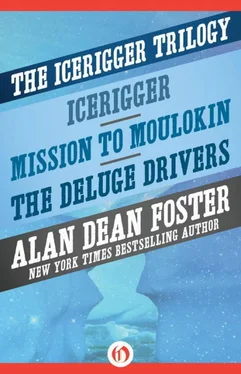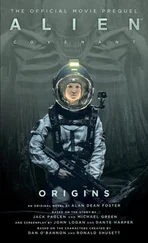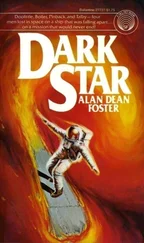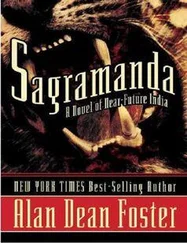But Calonnin Ro-Vijar was entirely too imaginative and enterprising to be trusted with anything as lethal as modern energy weapons. Nothing like a needler to give a primitive mind delusions of grandeur. No, Ro-Vijar would remain far more manageable, though never exactly docile, if his methods of violent argument were restricted to lance, arrow and sword.
That was important to Trell’s blueprint for the future development of Tran-ky-ky. Keep temptations from Ro-Vijar’s hands and he’d be less likely to conjure up awkward ideas. He touched a control which automatically imprinted his signature of approval on a request for certain materials for quartermaster division, then went on to the next tape.
Trell was perfectly correct in his overall assessment of Calonnin Ro-Vijar’s qualities, but he was wrong on one crucial point. The Landgrave did not need possession of modern weapons to inspire grandiose delusions. He had plenty of those already.
As he chivaned toward the harbor and his waiting craft, Ro-Vijar considered the details of his recent interview with the human Commissioner. If Trell would not provide him with light knives, he would obtain them somewhere else. Were there not three of the irresistible weapons on the persons of the humans he was going to kill? Once that disagreeable task was concluded, he could easily fabricate some clever story for Trell’s ears to explain the disappearance of the human’s weapons. Trell might be suspicious, but what could he prove?
If a cub could trip over a slithering megorph, could not a human trip over the future? These purveyors of wealth from the sky might be rich and wise. They were not omnipotent.
THE OBJECT OF CALONNIN Ro-Vijar’s avaricious thoughts was at that moment nearing the equator of Tran-ky-ky. It was near noon. Ethan was studying the ice sliding past below.
No matter where they passed, the sun always seemed to bring out hidden patterns in the ice ocean’s surface. But what Ethan noticed now startled him more than any fanciful face or half-concealed monster thrown back from subsurface cracks and discolorations.
In places, a thin layer of water lay on the ice. Widely scattered puddles formed unexpected mirrors. Once, the Slanderscree shot through a depression filled with enough water to send spray flying rail-high.
Several hours later, the temperature had dropped enough for the isolated pools to freeze solid again, but the mere sight of free-standing liquid water on Tran-ky-ky was a considerable shock.
It had a much more deleterious effect on the crew. They were used to seeing running water only in their homes, after ice or snow had been melted down for drinking. Their reaction would be comparable to a human watching the ground beneath his feet begin to dissolve. It was overwhelming to learn that one’s world was not indestructible.
Williams and Eer-Meesach moved among the jittery sailors, assuring them that their cataclysmic speculations were groundless, that there was no danger of the ice ocean melting more than a few centimeters in this one exceptionally warm place on the planetary surface. Regardless, Williams told them, the Slanderscree would surely float.
It took him a while to explain the concept of floating.
As soon as the sun dropped a few degrees and the surface water refroze, however, even the most superstitious sailors were convinced they had nothing to fear.
Several warning cries sounded that afternoon from the lookout baskets attached to the top of each mast. Ethan rushed to the helmdeck, the nerve center of the great icerigger, to learn what was happening.
He found Ta-hoding yelling commands to his mates, directing the reefing of several sails. Pika-pina sheets began to shrink in the forest of rigging and spars. Ethan forbore interrupting the captain when he was obviously so busy and was soon able to make out the cause of their slowing for himself.
A green thread lying across the fore horizon grew to become a ribbon, then a deep, verdant band. It stretched as far as a man could see from left to right across the ice sea. The band became a broad swatch and soon they were sliding over an ocean of green instead of white.
The massive duralloy runners of the Slanderscree left parallel grooves in the emerald-rust carpet of their wake. Sir Hunnar moved to stand alongside Ethan.
“’Tis one of the largest fields of pika-pina I have ever seen, friend Ethan. ’Twould be a good place to live, were there any high land about.” Ethan knew the adaptable, prolific plant could live anywhere it could sink its traveling roots into nutrient-rich soil. The islands hereabouts might be only a centimeter or two above the surface. Or perhaps the fields’ taproots went deep through the ice to penetrate subsurface mountaintops.
In places the thick, triangular stalks tended to a deep, rich green, in others the color turned almost red or brown. Hunnar talked on about the agricultural wealth of this unexploited, icebound prairie.
He didn’t use a complex collection of consonants, but instead referred to the growth by its most simple, colloquial name, for the benefit of speech-poor humans. Occasionally the passage of the icerigger would stir up clouds of batwinged butterflylike creatures, little knots of black, purple, and gray fur supported by wings seemingly too delicate to cope with Tran-ky-ky’s ferocious winds.
Larger arboreals would then rise to pursue. These had long thin snouts, almost half the length of their bodies, which were filled to crowding with curved, pin-thin teeth. Flapping membranous wings, they would swoop in among the bat-butterflies, mouths moving like scythes as they snapped at their agile but tightly packed prey. Pincushion jaws nearly always emerged from the colorful moving clouds with one or two punctured prizes.
Hunnar’s attention wandered to Eer-Meesach’s more learned explanations directed at the school teacher Williams. Though diminutive and wizened by adult Tran standards, the aged native wizard still towered over his human counterpart, his white-gray fur contrasting electrically with Williams’ satin black beneath his face mask.
“So we see that the pika-pina’s regenerative powers are so great that though it is cut today, it will have grown in behind us by this time on the morrow.” The wizard gestured with a shaky paw at the tracks in the path of the ship.
“If it can regenerate so fast,” asked Williams, “why doesn’t it spread until it covers every square meter of ice on the planet?”
“It is not that simple, friend Williams.” And Eer-Meesach repeated the method of pika-pina growth which Ethan had come to know and marvel at.
Long burrowing roots laboriously melted or wedged their way through the ice just beneath the surface until they located a cavity, usually an ancient air bubble trapped by freezing. The root would expand there to form a thick nodule. Nutrients concentrated in such nodules—which the Tran hungered after—were difficult to locate and hard to excavate. When the nodule was rich and large enough, it would send out four, five or more new roots in quest of other cavities, while the nodule’s supply of nutrients was constantly replenished from other nodules and eventually from some distant landmass.
“Thus,” the wizard continued, “with many nodules nearby, the pika-pina can quickly re-establish itself behind our ship, since root-paths have already been cut through the ice here. But to expand further into new territory, it must dig new pathways for itself through the resisting ice. This is why—”
A yell from the mainmast interrupted the lecture. Ethan looked forward, to where the field of green was becoming a wall.
“Pika-pedan,” he murmured to himself.
Ta-hoding was already studying the forest through a crude but serviceable Tran telescope. “It appears to extend,” he told Ethan, in response to the other’s question, “as far to east and west as its tiny cousin.” He put down the glass, looked worried.
Читать дальше










